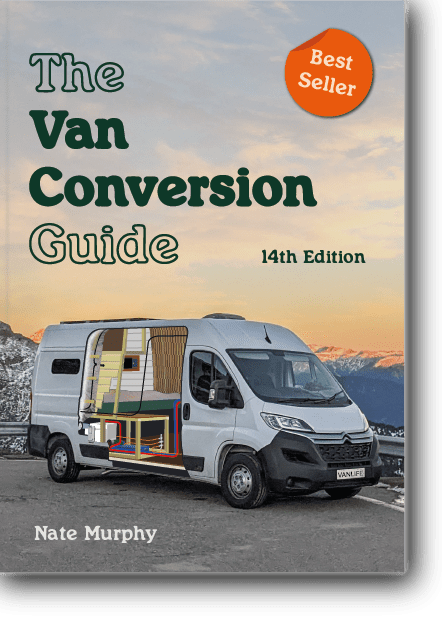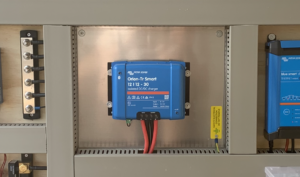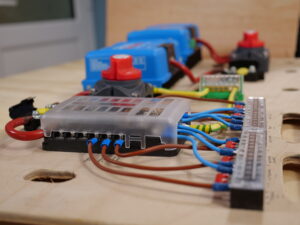Camper van batteries Everything you need to know!
last updated: Oct 2, 2023
Even a small amount of research into the world of leisure batteries will leave you frazzled. There are many types, sizes and considerations when choosing your batteries. Our guide below simplifies this for you.
Battery technology is developing faster than you can imagine. Batteries are becoming lighter, more powerful, and their life cycles are ever-increasing.
What is the best type of battery for a van conversion?
There are a few key fundamentals when it comes to leisure batteries that are worth understanding before you proceed with which type and size battery is best for you.

1. Depth of discharge
The first being depth of discharge (DOD). Depth of discharge is how far a battery can be discharged relative to its capacity. Different batteries have different depth of discharge ratings, some batteries can be discharged further than others.
We recommend that you always use a battery monitoring system, such as the Victron BMV range, to accurately determine the depth of discharge of your battery. Not only do the battery management devices monitor DOD, they also give you an array of information regarding your battery. Once setup correctly these monitors become extremely useful in your tiny build and help prolong the life of your batteries.

2. State of charge (SOC)
A battery’s state of charge is simply the amount of charge within the battery.
A fully charged battery would be 100% SOC whilst an empty battery would be 0% SOC.
The state of charge is the inverse of the depth of discharge. Put another way, if a battery is at 100% state of charge, then its depth of discharge is 0%. The opposite is also true. If a battery is 100% discharged, its state of charge is 0%.
3. Cycles
The third fundamental is a cycle. A cycle is when the battery has been fully charged, discharged and then fully charged again. Every time it completes this circle of events, that will be considered 1 cycle. Although by completing this cycle the battery is technically ageing, it also keeps the battery active and healthy. Different batteries have different life cycles, some more than others.
The number of charge cycles a rechargeable battery can withstand before performance degrades is the method we use to measure how long our batteries will last if taken care of properly.

4. Battery Lifespan
A battery’s lifespan is a time frame given by the manufacturer which depicts how many cycles a battery can perform in a certain period of time.
Over time your battery monitoring system may tell you your system is at 100% charge but this isn’t necessarily accurate. This is a depletion in its lifespan, the battery will take longer to charge and be quicker to discharge in some circumstances.
Batteries coming to the end of their lifespan also struggle to hold a charge, so if everything is turned off in your tiny build and the battery is struggling to hold a healthy voltage you know your batteries are on their way out. If we look after our batteries, connect them in the correct way and use the correct equipment to charge them they will live long and prosper!

5. Battery Capacity: The Basics
Battery capacity refers to the amount of energy a battery can store and deliver. It is typically measured in ampere-hours (Ah) or milliampere-hours (mAh). A higher capacity generally means the battery can store more energy and run appliances for a longer time before needing a recharge. In the context of leisure batteries, capacity is a key factor in determining how long you can power your devices away from a main power source.
Common Leisure Battery Capacities
Leisure batteries come in various capacities to cater to different needs and usage scenarios. Here are some common capacities you might encounter:
- 100Ah to 150Ah: These batteries are suitable for light to moderate use, such as powering small appliances, and lights, and charging electronic devices. They are often used in smaller campervans or for short weekend trips.
- 150Ah to 200Ah: Batteries in this range offer a balance between capacity and portability. They are capable of powering larger appliances like fridges and televisions for a reasonable amount of time. These batteries are often found in medium-sized campervans, caravans, and boats.
- 200Ah and above: High-capacity batteries are designed for extended off-grid trips and heavy power demands. They can handle running multiple appliances simultaneously, making them suitable for larger campervans, motorhomes, and boats with higher energy needs.
Choosing the Right Capacity
Selecting the appropriate leisure battery capacity depends on several factors:
- Usage Intensity: Consider the number and type of devices you’ll be running. Appliances like refrigerators and air conditioning units require more power than lights and phone chargers.
- Trip Duration: If you’re planning short trips, a lower-capacity battery might suffice. For longer excursions, a higher-capacity battery ensures you won’t run out of power unexpectedly.
- Recharge Opportunities: Will you have access to charging points along the way? If so, a lower-capacity battery might work, as you can recharge frequently. Otherwise, a higher-capacity battery offers more independence.
- Budget and Weight: Higher-capacity batteries tend to be more expensive and heavier. Consider your budget and the weight limits of your vehicle or vessel.
6. The Difference in Performance
The difference in performance between various leisure battery capacities lies in their endurance and power output. A higher-capacity battery can sustain power-hungry appliances for a longer time, while a lower-capacity battery might require more frequent recharges or careful power management. Additionally, larger-capacity batteries usually have a longer lifespan due to their ability to handle deeper discharges without significant harm to their overall health. They also tend to support more charge/discharge cycles compared to their smaller counterparts.
How can you increase the life of your batteries?
Once you begin to understand how different factors impact your battery’s life cycle, it becomes clearer how you can increase your battery’s life. Following some simple “best practices” can help you get the most out of your battery, regardless of whether it’s a lead-acid or lithium-ion battery.
Best Practice 1: As much as possible, use your battery in moderate temperatures. Of course, this may not always be possible but if you can keep your batteries in moderate temperatures this can have a dramatic effect on its life cycles. The optimal temperature for most batteries is between 20 – 25 degrees centigrade. Lithium-ion batteries are particularly sensitive to discharging and charging in colder weather. To get around this you can surround your batteries with heat pads to keep them warm and operating efficiently.
Best Practice 2: If you have a lead-acid battery (FLA, AGM, GEL) ensure that you minimise how often you discharge the battery below 50% of its capacity. Ideally, the depth of discharge on each cycle should be between 10% and 50%. If you have a lithium battery, you can likely go down to 80% DOD and, in some cases, 100% DOD. Refer to your battery manufacturer’s recommendations to be safe.
Best Practice 3: If you have a flooded lead-acid battery, make sure to keep the electrolyte solution topped up.
Best Practice 4: Ensure you use the correct charging equipment for your batteries. Better yet, ensure the charging equipment that you are using has the correct charge parameters for your battery type. These parameters vary from battery type to battery type and need to be done correctly. This is something that we, at Tiny Build Electrics, can help you with.
Different Types of Battery for Van Conversions
Choosing your batteries is something you want to get right, after all, no one wants to be sat in the dark sipping warm beers, right?!
Understanding the types of batteries available, the capacity you need for your van lifestyle, the relative cost and how to take care of them will help when it comes to choosing the best camper van batteries for you.
The four battery types we will be considering are:
- Flooded Lead Acid batteries (FLA)
- Gel batteries (GEL)
- Absorbed Glass Mat batteries (AGM)
- Lithium-ion batteries (LiFePO4)
Each type has a different make-up and because of this performs differently under different conditions.
Flood Lead Acid (FLA) Batteries
Flood lead-acid batteries consist of two lead plates, one positively charged, and the other negative. The battery is then flooded with a liquid electrolyte, sulphuric acid which covers all internal parts. When charging commences the acid and lead plates react to store electricity.
Pros
- Low cost
- Resilient to occasional overcharging
- Proven technology
- Lifespan can be 4-8 years with regular maintenance and careful charging
- Less susceptible to temperature differences
Cons
- As the batteries age the performance will degrade to the point where the battery won’t hold a charge
- Should be stored inside an enclosure (battery box)
- The battery can only be drained to a maximum DOD of 50%, otherwise, you’re likely to incur damage.
- Must be vented in an enclosed area as some FLA batteries will emit gases.
- Stricter regulations on how FLA batteries are fitted and how close they are installed to inverters and chargers.
- Require regular maintenance
- Heavy
Gel Batteries
Gel batteries use the same technology as FLA but instead of liquid acid, they are filled with Gel.
Gel batteries gives us more advantages than FLA as you will see below.
Pros
- Doesn’t emit any nasty gases
- Sealed so can’t leak or produce any gas
- Maintenance free
- Operates in a wider array of temperatures than AGMS.
- Ideal for vans that are stored over winter and not used for long periods of time
Cons
- Very sensitive to depth of discharge
- Do not recover well from a low DOD
- More expensive than conventional FLA and AGM
- Heavy
Absorbed Glass Mat (AGM) Batteries
AGM batteries work in a similar manner to FLA and Gel.
Instead of acid or gel they have electrolyte-soaked glass fibres between the positive and negative plates.
Pros
- Long shelf life
- Maintenance free
- Ideal for vans that are stored over winter and not used for long periods of time
- Can be installed sideways as it is a sealed unit and cannot leak (unless damaged)
- Smaller than the conventional Gel equivalent
Cons
- Very sensitive to depth of discharge
- Do not recover well from a low DOD
- More expensive than FLA
- Heavy
- Poor performance in colder temperatures
Lithium LiFePO4 / Lithium-ion / Li-ion Batteries
The famous lithium-ion battery. If you have done any sort of research on van conversions or off-grid systems then it is highly likely you have come across the lithium battery, currently at the top end of the battery technology market. This is a battery you should be considering for your build, there’s just one downside… £££!
Pros
- 30% lighter than FLA, GEL & AGM
- Smaller frame size than FLA, GEL & AGM
- 90% of their capacity is usable meaning you need less battery for the same amp hours as FLA, GEL & AGM
- Low internal impedance (resistance) means these batteries also charge a lot quicker than the other types of batteries.
- Can be installed in various orientations
- Maintenance Free
- Long life cycles if charged and discharged in accordance with manufacturer instructions
Cons
- Very sensitive to charging in low temperatures
- Expensive, although prices have started to drop over the past few years
- A battery management system is required to protect the lithium-ion battery bank from excessive discharging, overcharging and to control the load and balancing of each internal cell. Most of the time this system is built into the battery itself.
- Some extra monitoring may be required such as battery temperature monitoring
Leisure Battery Price Comparison
| Battery Type | Average Life Cycles @ 50% DOD | Price (£) (TBE SHOP) | Cost per Cycle (£) |
| Victron Energy 110ah AGM Battery | 850 | 316.99 | 0.37 |
| Victron Energy 100ah LiFePo Battery | 5000 | £1,275.60 | 0.26 |
The table above clearly shows us that whilst the lithium-ion battery is more expensive than an AGM battery, it certainly is cheaper when you consider the cost per cycle over the lifespan. The life cycle of the lithium-ion battery is unmatched and is something to seriously consider if you want a ‘fit and forget’ electrical system in your campervan.
A case study: the effects of upgrading camper van batteries from AGM to Lithium
My friend Tom upgraded his campervan system from absorbed glass mat (AGM) to lithium-ion at the end of 2021. The main reason for this change was to save weight as he knew his self-build van conversion was starting to get heavy. He removed my AGM batteries and weighed them. Both batteries weighed in at a whopping 35kg each! 70kg of batteries being pulled around by my van. It is not only the weight though, as the absolute maximum DOD was 60% for my two x 100ah batteries which meant I only actually had 80ah of usable power.
Well, each lithium battery weighed in at… 11kg, yes… 11kg! 70kg taken out and replaced with 22kg. The weight saving was the ultimate goal but what was even better was the power upgrade. My two 100ah lithium batteries now gave me 180ah of usable power, this is because the lithium batteries can be drawn down to 10% DOD without causing any damage. (They can theoretically go to 0% but most manufacturers do not recommend this) He had literally doubled my power bank whilst saving two thirds of the weight!
Tome has not had any power worries since and because he has an electric hot water system the batteries take a beating. They cycle regularly but with a manufacture rating of over 5000 cycles this is not something he is worrying about yet either!

Can I use a vehicle engine battery as a leisure battery?
Starter batteries are the type of batteries that are used in cars, boats, lorries, buses and generators. Starter batteries are not suitable for uses where they are discharged and then recharged again, also known as cyclical use.
They also cannot be used in connection with an inverter, although technically they can the battery’s make-up means that it will not last very long while feeding an inverter.
The reason that start batteries are not suitable for frequent deep discharging is because of the way they have been constructed. They have thin plates with a large surface area. They are designed purely for short-term high discharge currents like engine starting.
During an engine starting the battery is exposed to high current draw in a short period of time. This high current draw turns a starter motor which, in turn, causes the engine to turn over and start. It might be tempting to use start batteries in a battery bank in smaller inverter systems, but please don’t do it. It will only cause trouble in the long run.

Summary
If you want the cheapest method of powering your tiny build then Flood Lead Acid is for you.
These batteries are as cheap as chips and can be picked up in various frame sizes as well as Amp Hour sizes. But please note, these batteries need ventilation and you need to monitor them to ensure they do not leak. We advise against installing FLA deep in your build. They need to be installed within a battery enclosure and well vented so that should they need to vent or, worst case, leak. When they vent, FLA batteries will emit dangerous gases into your campervan or motorhome.
If you are wanting a ‘fit and forget’ system with efficiency and a long cycle life then Lithium-ion is for you.
The lithiums are expensive, but, they are slowly coming down in price due to their popularity. When you consider the price of lithium you must consider its lifecycle and DOD. Considering that an AGM battery will enter in at around 500 cycles, lithiums are 5000+ cycles. Not only will they last longer (if installed and charged correctly) they are A LOT lighter which is important when it comes to conversions such as vans, motorhomes, buses and lorries which have weight limits.
Build your own adventure
The guide anyone can use to convert a van into a camper! With over $350 worth of savings inside
Do you want to live vanlife at zero cost?
Nate Murphy knows how to buy vans, convert them quickly and efficiently - use them for years - and then sell them for a profit. This can make vanlife not just free, but profitable!
He has successfully done this for years and he teaches his friends and students to do exactly the same. It is not obvious, but anyone can do it if they have the knowledge!
Join Nate at his free online training (running today) and he will teach you exactly how he does this!


The Van Conversion Guide (14th Edition)
The guide anyone can use to convert a van into a camper! This best-selling guide, now in its 14th Edition, has been used by thousands of people to transform a van into a camper.
- 150+ page eBook
- Helps you convert any kind of van
- Diagrams for all the main systems
- FREE mini-course - 28 video tutorials


